For those new to the sport we know that starting to play padel can be slightly confusing at first but don’t worry we are here to help.
If you have experience of playing tennis many of the below concepts will be familiar but there are still several differences due to the court structure.
In this beginner’s guide on how to play padel we will explain the padel court, the basic rules and scoring of a padel match so that you can quickly start playing with confidence.
Contents
1. What is Padel or Padel Tennis? Brief Overview
Padel tennis, simply known as “padel,” is a racket sport that blends elements of tennis, squash, and badminton, but without the strings!
Created in Mexico in the late 1960s, the game has spread across the globe, reaching Europe by the 1970s. Today it is one of the fastest growing sports in the world.
Padel is played on a court in doubles format, creating a more social sport.
The game emphasizes positioning, control and strategy over power and speed, making it accessible and enjoyable for a wide range of participants.
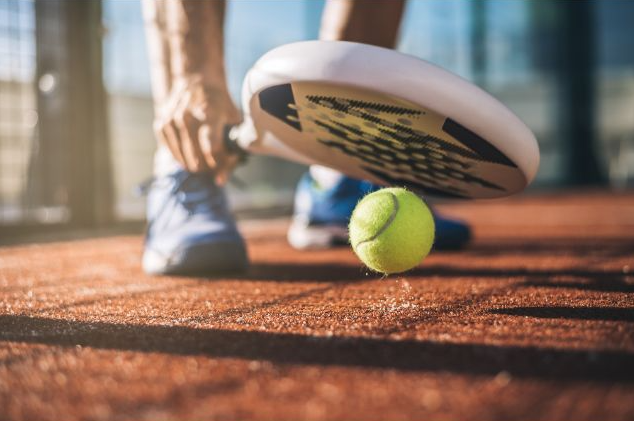
Padel Racket and Padel Balls
The equipment needed to play padel includes a padel racket, padel balls and a pair of sports shoes.
Padel rackets are all approximately the same weight and length but may come in three different shapes: round, diamond and tear drop.
Unlike tennis and other racket sports, padel rackets have no strings and instead have numerous small holes in the face of the racket that allow air to pass through easily.
The surface of the padel rackets may have a smooth or rough finish which impacts how much spin can be applied to the ball.
The padel balls are similar to tennis balls but with less pressure and less bounce. Padel balls, like tennis balls, are usually replaced on average every five or six matches.
2. The Padel Court
A padel court is unique and combines parts from tennis and squash.
The court dimensions measure 20 meters in length and 10 meters in width, enclosed by walls on all sides, much like a squash court. However, unlike squash, these walls are not entirely solid.
The lower 3 meters on the back wall and adjoining first 2 meters of the lateral wall sections are usually made of transparent material such as glass, giving a regular rebound to the ball.
The remaining sections are made of metallic fencing, which provides an irregular rebound.
Padel courts are divided in two by a net, like a tennis court.
On each side, there’s a service line placed 6.95 meters from the net, dividing the area into two parts.
A center service line extends perpendicularly from the net to the service line, creating two service boxes.
The court playing surface can be made of concrete, synthetic material, or artificial turf, providing a regular bounce to the ball.
Entrances to the padel courts are situated on either one or both sides.
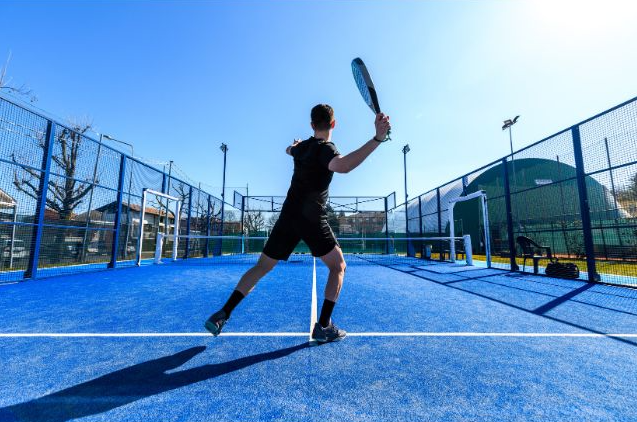
3. Padel Rules
The rules of padel tennis echo many rules of tennis but incorporate a few unique elements due to the court structure.
The key rules to get you started include:
The serve
The padel serve must be underarm, starting from a position level or below the waist.
The ball must bounce once, behind the service line on the server’s side of the court, before being hit towards the diagonally opposite service box in the opponent’s court.
The ball must hit the ground in the opponent’s service box, including the lines, before it can be played by the opponent.
The ball may land in the opponent’s service box and then immediately hit the side or rear wall, a more difficult ball for the opponent to return.
The server has two serve attempts for each point. The second serve is used when the first serve is a fault. If the second serve is also a fault the point is lost.
When is a serve a fault?
The term ‘fault’ means that the ball or player has done something that is incorrect and not permitted by the rules.
The serve is a fault:
If the ball lands on the ground anywhere outside the opponent’s service box.
If the ball first hits the metal fencing or any side or back wall directly.
If the ball hits the ground in the opponent’s service box and then directly hits the metal fencing.
If the ball hits the net and then lands outside the opponent’s service box.
If a server’s foot touches their own service box area or the line before the ball is hit.
When to replay a serve?
If the ball hits the net but lands in the correct service box and does not immediately hit the metal fencing, it is known as ‘a let’. A let is called, and the server replays the serve.
This applies to both the first and second serve.
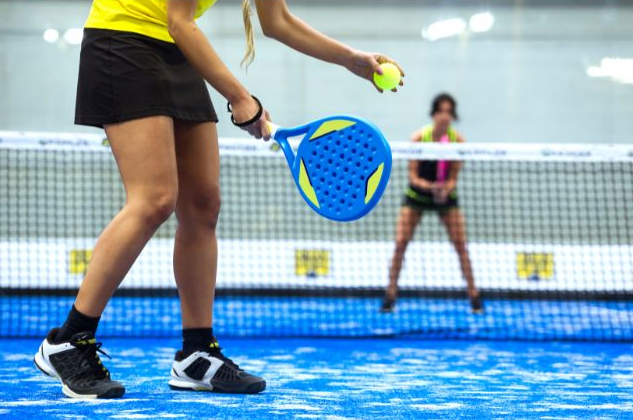
Player’s court positions at serve
Server’s position:
A server starts their service game from the right-hand side service box and alternates after each point.
This continues until the game is won or lost or a golden point is reached, (see below), when the receiving team choose which side to receive the serve.
Server’s partner position:
The server’s partner may switch side each point or remain in their original position.
The server’s partner will generally be standing half-way between their service line and the net.
Opponent’s position:
The opposing team will normally both be standing in the area between the back wall and their respective service box.
Who serves first?
There are many ways to decide which team serves first, here are two examples:
Toss a coin. Winner chooses which team serves first.
Play a point with a minimum number of shots to cross the net before the ball is ‘live’. The winner of the point chooses which team will serve first.
It is then up to the players in a team to decide which one will serve first.
Ball in play
Following the serve the receiving player hits the ball back over the net after the bounce from the ground or after the subsequent rebound from the side or rear walls.
The receiving player may hit the ball against their own side or rear walls to make the ball cross the net. They may not use the metal fencing.
This continues until a team wins or loses the point.

How do I win the point in Padel?
A team wins the point if:
The opponents fail to return the ball over the net after the ball bounces on the ground on their side, or when hitting the ball directly before it hits the ground on their side, (regular play only).
The opponents hit a ball which after crossing the net hits the side walls, back walls, or metal fencing directly before bouncing on the ground.
The opponents hit the ball outside of the court without it first hitting the ground on your side of the court.
After returning the ball over the net the ball first hits any part of your opponent’s body, clothing, watch etc.
An opponent touches the net or crosses the net with their padel racket to play a shot.
How do I lose the point in Padel?
A team loses the point if:
The ball bounces twice on the ground on your side of the court.
You fail to serve without fault twice in a row (excluding lets). This is called a ‘double fault’.
You hit your partner’s body or padel racket with the ball.
You hit the ball onto the metal fencing on your side of the court.
You hit the ball into the net or hit the net with your padel racket.
The ball directly hits the walls or metal fencing in the opponent’s court, or goes outside of the court, before hitting the ground on the opponent’s side.
4. Padel Scoring
The point system in padel mirrors much of tennis.
Winning points wins games, games win sets, sets win the padel match.
Here’s a basic breakdown:
Padel points
Points progress from 0 (often called ‘love’) to 15, then 30, and then 40. If both teams reach 40, it’s called ‘deuce’.
At deuce a golden point is played, meaning the team that wins the next point wins the game.
The golden point replaces the ‘advantage’ scoring stage of tennis.
‘Advantage’ scoring means that a team needs to win the point when the game is at deuce, taking them to the score of ‘advantage’ to them, then they must also win the next point to win the game.
If they lose that point the score returns to ‘deuce’ and both teams battle to win the next point to reach ‘advantage’.
You can choose to play padel with the advantage style of scoring but it will often make the games much longer.
Described differently for those not familiar with tennis
A game is won if a team wins four points.
Points for each team progress from 0 to 1, to 2, to 3, to game won.
(Examples: 1-0, 2-1, 3-2, 4-2)
2-2 is the same as 30-30
1-3 is the same as 15-40
3-3 is the same as ‘deuce’
4-3 is the same as game won by golden point
4-2 is the same as game won versus 30.
Padel games
The first team to reach six games, leading by at least two games, (Examples: 7-5, 6-4, 6-1) wins the set.
When the number of games completed is an odd number the teams change ends, for example after 1, 3, 5, 7, 9 or 11 games.
If the game score reaches 6-6, a tiebreak is played.
What is a tiebreak in padel?
A tiebreak is the way to decide who wins the set when the set is tied at 6-6 in games.
In the tiebreak, the first team to reach seven points with a minimum lead of two points wins the set. Tie break winning scores examples: 8-6, 7-5, 6-4, 6-1.
Sometimes a super tiebreak is used. This normally means the first team to 10 points with a lead of two points will win the tiebreak and the set.
A super tiebreak may be used instead of a full third set when the score in sets is 1-1 for a best of 3 sets match, or 2-2 if playing a best of 5 sets.
The use of a super tiebreak can speed up the completion of a match, very useful for the organisers of tournaments and competitions.
After the tiebreak the result in number of games will be 7-6 to one of the teams.
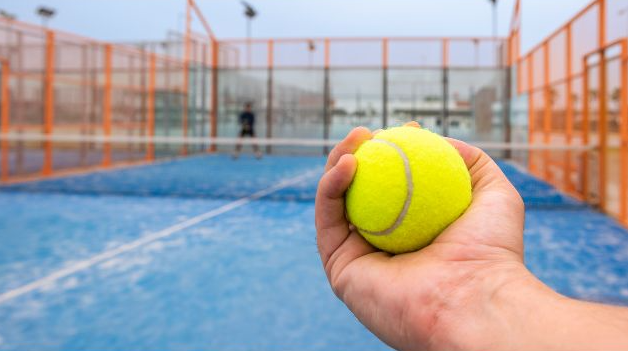
Serving during a tiebreak
The first point of a tiebreak is served by the person who started the set.
As 12 full games have been played by this stage everyone will have served 3 games each.
After this first point the next two points will be served by the opposition server in the same order as during the set.
This change of server then continues every two points until the tie-break is won.
After every 6 points during a tiebreak the teams change ends, for example at 5-1, 4-2, 3-3 or 6-6.
Padel sets
Matches are usually the best of three sets, first to two sets.
Sometimes a match may be the best of five sets, first to three sets.
Short sets, first team to four games, or normal sets of six games with super tiebreaks may also be used.
You can create your own format or combination to suit your group and time available.
If a team wins a set and an even number of games have been played then the teams do not change ends at the start of the next set.
5. When Can I Have A Break Whilst Playing Padel?!
The rules of padel normally allow a 90 second break at every change of ends, except after the first game where, like the change of ends during a tie break, only 20 or 25 seconds are usually allowed.
There is also a 2-minute break at the end of a set even if you do not change ends.
Of course if your game is more friendly or social in nature you can take as long as you all choose!
Conclusion
You now know:
the basic overview of padel,
the padel court components,
the main rules of padel,
the scoring system for padel, and
when you can have a rest, discuss tactics and rehydrate!
With this information you will be able to step onto the court and start playing padel with confidence.
It is likely that as you play padel more regularly you will pick up a few of the other padel rules not mentioned here.
If you can’t wait that long then please check out our guide to the less well known rules and regulations of padel!
We recommend that you also read this guide on how to win more points as a new padel player.
Happy padel playing!
FAQs
Is padel a good game for the whole family?
Absolutely! Padel is great for families. It is easy to pick up the basics and everyone will feel involved.
As the court is smaller than a tennis court it is much easier to get the racket onto the ball and feel like you are all making progress.
How can I quickly improve my padel skills?
There are many online tutorials and articles that will help you focus on the various parts of the game.
We recommend trying to master the serve and return first as these are the shots where you will be most in control and can practice the most often during a game.
What should I wear to play padel?
Comfortable sports clothes and padel shoes with relatively flat soles are ideal. For added style you and your partner can wear matching t-shirts.
Do I need protective glasses to play padel?
It is good idea to wear special sports glasses if you wear prescription glasses. Those who don’t need prescription glasses rarely wear protective glasses.
Players do wear sunglasses whilst playing padel in the sun or bright conditions.
Is padel dangerous?
As with any sport played in close proximity to other players and solid walls care should be taken whilst playing padel.
Padel rackets have wrist leashes that must be worn to prevent the racket slipping out of a player’s hand and causing injury.
Are padel injuries common?
It is sensible to warm up properly before playing padel to reduce the risk of injuries.
Taking care to make sure there are no loose balls on the court whilst playing a point is also recommended.
As with most racket sports there will be injuries from time to time. Knees, shoulders, elbows and wrists are often areas that padel players need to rest.
Can I play the ball from outside the padel court?
Yes! If the ball has bounced on your side of the court and travelled outside the court boundary you are allowed to run out of the court and hit the ball back into the opponent’s area.
This is quite an advanced shot to attempt but very rewarding if you are fast enough!
How long can a padel point last?
6 minutes and 48 seconds! That is the longest point in ‘World Padel Tour’ history. It took place in Mexico in 2021.
A long point, also known as a ‘rally’, happens quite often in padel. Much more so than in tennis. This is one of the attractions of padel.
Even at a beginner level it is not hard to have a 10 shot rally or longer.
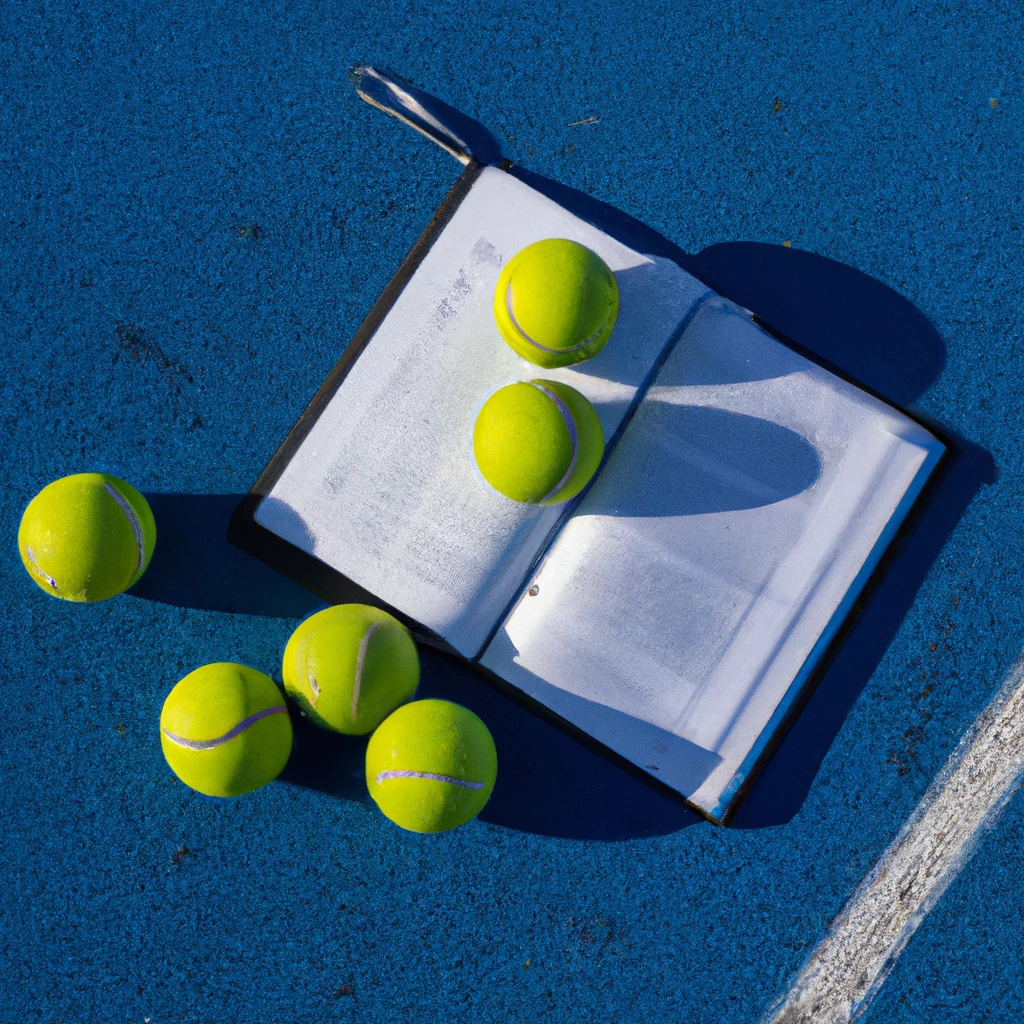
Comments
One response to “Padel Rules: The Beginner’s Guide On How To Play Padel”
[…] popular than Tennis.If you are a new padel player or a convert to padel from tennis then see our beginner guide to padel and also our guide on how to win more […]